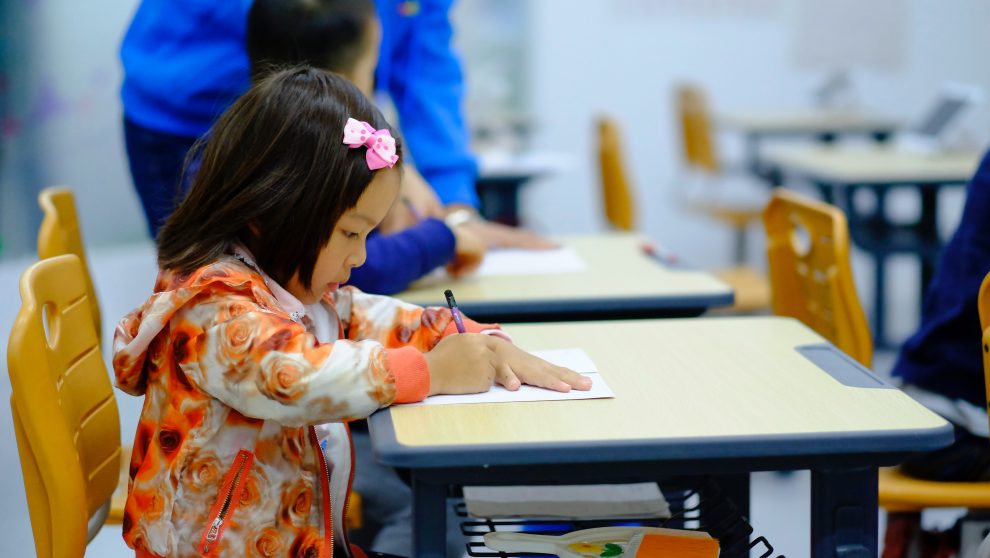“Why do you send your boys to a Catholic school?” my sons’ pediatrician asked, looking at the St. Monica school sweatshirts and uniform pants my two boys had strewn over the floor of the examining room. It was the boys’ yearly checkup, in 2002, and they sat expectantly in their Hot Wheels underwear as their doctor walked in.
“You live in one of the top school districts in the state,” the doctor continued, taking out an instrument and peering into 4-year-old Liam’s ear. “You’re paying for those schools with your taxes. You should be taking advantage of them.” He tapped Liam on the knee with a tiny hammer, and Liam’s eyes widened as his leg shot up in reflex.
One of the reasons I liked my sons’ pediatrician was that he wasn’t afraid to challenge me. Whether he was trying to persuade me to buy organic produce or switch the boys from regular milk to soy milk, the doctor had an opinion on everything, and I always left his office with something to think about.
As the doctor finished with Liam and moved onto 7-year-old Jacob, I explained that while my husband and I have great respect for the public schools in our area, we wanted our boys to learn about their faith on a daily basis.
“But you can teach them that at home,” the doctor said. “Save your tuition money.”
At home. I remember thinking that while I didn’t know how other people’s homes functioned, I did know that matching St. Monica’s 45 minutes of daily religious instruction would be a stretch in our household, where some days we didn’t have an extra 45 seconds to find a matching pair of socks. Even more than the daily religion classes, there were a thousand tiny things that happened over the course of a year at a Catholic school—moments we would have to give up if we chose public education over Catholic. And now, 16 years after that pediatric visit, with two daughters in addition to those little boys, a little more wisdom, and 16 more years of Catholic education at the elementary, high school, and college levels, I would confidently tell the doctor that we were putting our money in the right place.
At the grade school level I would not have been able to give them the prayer experience of 20 children and a teacher gathered in a circle, reading from a children’s Bible. And our prayers together wouldn’t be nearly as age-appropriate—I wouldn’t have known where to begin looking for all the cute hand-motion prayers and Jesus songs. I doubt that I would have found the energy to have the boys make their own Advent wreaths or draw stations of the cross booklets for Lent.
At the high school level the gift of a Catholic school deepened in a way I could not have imagined as a mom of little boys with race car underwear. Now, with two sons who are high school graduates and two daughters who are students at Dominican High School, I see the years between 14 and 18 as a time of self-discovery and for adolescents to develop a moral compass and establish a worldview. Dominican pairs this time of development with direction rooted in gospel values. Dominican points their students to St. Catherine of Siena, who instructed, “Be who you are called to be and you will set the world on fire.” Their Catholic high school is allowed the privilege of looking at social issues and morality through the lens of faith and challenging students to do the same. At a moment when my adolescents may be tired of hearing me preach, they will hear the same core message from a younger, cooler teacher. And, more important, they are given the opportunities to discuss issues of justice and faith with their peers in daily religion classes or through campus ministry, learning servant leadership firsthand by reading at Mass, leading retreats, or organizing service trips.
When Jacob was still at St. Monica elementary school, I remember packing his lunch in the morning and asking if they prayed before lunch.
“Of course,” Jacob said, looking at me as if I had asked him if they use pencils in second grade. Not wanting to be outdone, Liam pointed out that the kindergarteners pray before snack, since they don’t stay for lunch.
If we had not chosen Catholic schools, we would have needed to give up the all-school Masses—the homilies aimed at our children—addressing the age-appropriate issues faced by our kids. The gift of Mass during the school day teaches children and adolescents the power of coming together as community to worship. It allows them to see their teammates, friends, and even those kids they don’t get along with as members of one community, joined in a purpose greater than math class or varsity basketball.
And yet as much as I have loved my children’s experience of Catholic school, it has been tinged with the sadness that comes with the injustice inherent in the price tag. My children’s Catholic school experience includes financial sacrifice by my husband and me, but it also includes generous gifts from grandparents and a few other relatives who value Catholic education. We could not have afforded four kids in Catholic schools without the support of our extended family. The expense of Catholic schools puts the experience out of reach of many families who would love to attend. The difference in resources of Catholic elementary and high schools in wealthy areas versus those in the central city is sinful—are we not one church?
In the first half of the 20th century the service of sisters allowed Catholic schools to be affordable and often free for parish families. Our church has changed, and so has education. Laypeople stand in the places of sisters and smart boards in the place of chalkboards. Advances in pedagogy and curriculum come with a cost. If we as a church see a value to steeping our youth in the practices and traditions of our faith, we must find a way to support Catholic schools as a community, to underwrite more of the cost to individual families.
The thousand reasons that add up to a rationale of why our church community should support our Catholic schools are as small as a crucifix in a classroom and as large as weeklong service trips. The reasons are as varied as the different languages and cultures of the saints themselves. The thousand reasons for supporting a Catholic school are imperfect—as imperfect as the people of God who make up the school. Some of our reasons are not reasons at all, but rather questions—questions about faith and life and God that a Catholic school cannot answer but only honor.
Being a follower of Christ comes with great personal cost and sacrifice, and to be Catholic is to be part of a worldwide community committed to supporting each other on the journey. Helping our young people to become followers of Christ includes giving them the opportunity for a Catholic education—a mission that will require all of us to come together and solve the issue of price.













Add comment